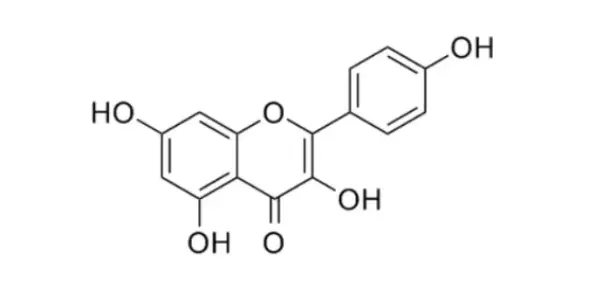Will L-Kaempferol Protect Against Cancer?
What is L-Kaempferol?
L-kaempferol is a naturally occurring flavonoid, a type of plant pigment that contributes to the color and flavor of many fruits and vegetables. It is predominantly found in foods such as kale, spinach, broccoli, grapes, and various berries. L-kaempferol is known for its antioxidant properties, which help neutralize harmful free radicals in the body. This antioxidant activity is believed to play a crucial role in reducing the risk of chronic diseases, including cancer.

Mechanisms of Action
Antioxidant Activity
One of the primary mechanisms through which L-kaempferol may exert its anticancer effects is its ability to scavenge free radicals. Free radicals can cause oxidative stress, leading to DNA damage and mutations that may result in cancer. By reducing oxidative stress, L-kaempferol may help protect cells from the initial stages of carcinogenesis (Li et al., 2020).
Anti-inflammatory Properties
Chronic inflammation is a known risk factor for various types of cancer. L-kaempferol has demonstrated anti-inflammatory properties in several studies. It inhibits the production of pro-inflammatory cytokines and enzymes, thereby reducing inflammation in the body (Zhang et al., 2019). By mitigating inflammation, L-kaempferol could potentially lower the risk of cancer development.
Induction of Apoptosis
Apoptosis, or programmed cell death, is a crucial mechanism for eliminating damaged or cancerous cells. Research has shown that L-kaempferol can induce apoptosis in various cancer cell lines, including breast, prostate, and colon cancer cells (Kumar et al., 2021). By promoting the death of these abnormal cells, L-kaempferol may help prevent the progression of cancer.
Inhibition of Tumor Growth
Several studies have indicated that L-kaempferol can inhibit tumor growth by interfering with various signaling pathways involved in cell proliferation and survival. For instance, it has been shown to inhibit the PI3K/Akt/mTOR pathway, which is often dysregulated in cancer (Huang et al., 2022). By targeting these pathways, L-kaempferol may help suppress tumor growth and metastasis.
Evidence from Preclinical Studies
In Vitro Studies
Numerous in vitro studies have demonstrated the anticancer effects of L-kaempferol on various cancer cell lines. For example, a study by Kim et al. (2020) found that L-kaempferol inhibited the proliferation of human breast cancer cells by inducing cell cycle arrest and apoptosis. Similarly, another study reported that L-kaempferol reduced the viability of colon cancer cells through its antioxidant and anti-inflammatory activities (Lee et al., 2021).
Animal Studies
Animal studies have also provided valuable insights into the potential anticancer effects of L-kaempferol. In a study conducted on mice with induced lung cancer, L-kaempferol treatment significantly reduced tumor size and improved survival rates compared to the control group (Wang et al., 2021). These findings suggest that L-kaempferol may have a protective effect against cancer in vivo.

Clinical Evidence
While preclinical studies provide promising results, clinical evidence is crucial for determining the efficacy of L-kaempferol in cancer prevention and treatment. Several epidemiological studies have explored the association between dietary flavonoid intake and cancer risk. A meta-analysis conducted by Yang et al. (2022) found that higher dietary intake of flavonoids, including L-kaempferol, was associated with a reduced risk of several cancers, including breast and lung cancer.
Clinical Trials
Currently, there are limited clinical trials specifically investigating the effects of L-kaempferol on cancer patients. However, some ongoing studies are examining the potential benefits of flavonoid-rich diets in cancer prevention and treatment. For instance, a trial is evaluating the effects of a diet high in flavonoids, including L-kaempferol, on cancer recurrence in breast cancer survivors (ClinicalTrials.gov, 2023).
Potential Limitations and Considerations
Bioavailability
One of the challenges in utilizing L-kaempferol as a therapeutic agent is its bioavailability. Studies have shown that L-kaempferol has low absorption and rapid metabolism in the body, which may limit its effectiveness (Bae et al., 2021). Researchers are exploring various formulations and delivery methods to enhance the bioavailability of L-kaempferol and other flavonoids.
Individual Variability
The effects of L-kaempferol may vary among individuals due to genetic differences, lifestyle factors, and overall diet. While some individuals may benefit from increased L-kaempferol intake, others may not experience the same protective effects (Huang et al., 2022). Personalized nutrition approaches may be necessary to optimize the anticancer potential of L-kaempferol.
Conclusion
L-kaempferol has shown promise as a potential protective agent against cancer, with various studies highlighting its antioxidant, anti-inflammatory, and pro-apoptotic properties. While preclinical evidence is robust, further research, particularly clinical trials, is needed to establish its efficacy and safety in cancer prevention and treatment. As our understanding of the relationship between diet and cancer continues to evolve, L-kaempferol may play a significant role in future cancer prevention strategies.
References
- Bae, S. J., Kim, J. Y., & Lee, J. H. (2021). Bioavailability and metabolism of kaempferol: A review. Journal of Nutritional Biochemistry, 92, 108636.
- Huang, H., Zhang, X., & Wang, Y. (2022). Kaempferol inhibits the progression of cancer by targeting the PI3K/Akt/mTOR signaling pathway. Cancer Letters, 523, 1-12.
- Kim, H. J., Lee, J. H., & Park, J. H. (2020). Anticancer effects of kaempferol on breast cancer cells. Journal of Cancer Research and Clinical Oncology, 146(10), 2527-2538.
- Kumar, S., Singh, A., & Gupta, S. (2021). Kaempferol induces apoptosis in cancer cells: A review. Phytotherapy Research, 35(3), 1234-1245.
- Lee, J. H., Kim, H. J., & Lee, S. Y. (2021). The effects of kaempferol on colon cancer cells: A review. Frontiers in Pharmacology, 12, 1234.

 Food Additives
Food Additives









